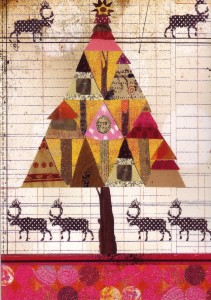Conscious Cooking
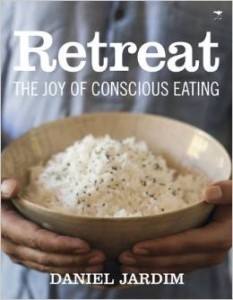 One of the big things I miss when I come home from retreat is having all my meals cooked for me. There’s no shopping, no cooking, no need to even think about what I’m going to have for dinner. The food on retreat is (almost) always really good. Not fancy. But fresh and flavorful. (There have been some significant exceptions to this rule, but I won’t go into those here.)
One of the big things I miss when I come home from retreat is having all my meals cooked for me. There’s no shopping, no cooking, no need to even think about what I’m going to have for dinner. The food on retreat is (almost) always really good. Not fancy. But fresh and flavorful. (There have been some significant exceptions to this rule, but I won’t go into those here.)
At Dharmagiri we had fresh-baked bread everyday and lots of roast vegetables (especially butternut squash, beets, corn and carrots), frittatas, soups, curries with chutney, and delicious fruit salads (mango, pineapple, peach, banana and grapes with avocado and pumpkin seeds was my favorite).
I obviously couldn’t bring the Dharmagiri cook home with me, but I did notice that there was one particular cookbook out and open on the kitchen counter… Retreat: The Joy of Conscious Eating, by Daniel Jardim….and I’m thinking that maybe having the cookbook will inspire my non-retreat meals to be more retreat-like.
I’ve ordered the book. I’ll keep you posted.
Postcards from Sacred Mountain (Dharmagiri)
I’m back from the month-long retreat at Dharmagiri in South Africa and (almost) over the jet-lag. (It’s a 16 1/2 hour flight just from Jo’burg to Atlanta!) I didn’t take a lot of photos — this wasn’t a sight-seeing trip like last year in Burma — but I did at least “document” the retreat center.
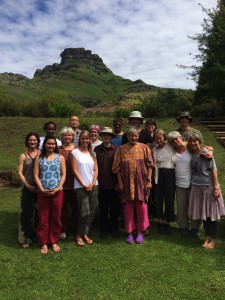 This is the group of retreatants. That’s me, with the pink-streaked hair, standing behind teacher Kittisaro (short guy, wearing a hat). Thanissara, his wife and c0-teacher, is standing in the back (with glasses and dark hair).
This is the group of retreatants. That’s me, with the pink-streaked hair, standing behind teacher Kittisaro (short guy, wearing a hat). Thanissara, his wife and c0-teacher, is standing in the back (with glasses and dark hair).
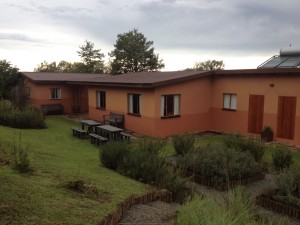 This is the meditation hall, with breezeway leading to the kitchen/dining hall.
This is the meditation hall, with breezeway leading to the kitchen/dining hall.
 These are some of the cabins for retreatants. The center can house 12. My room (with private bath) is the second from the left.
These are some of the cabins for retreatants. The center can house 12. My room (with private bath) is the second from the left.
 This is the view from my window.
This is the view from my window.
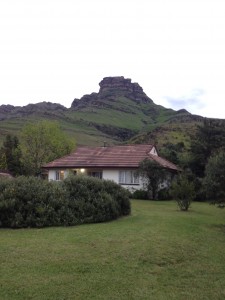 This is the main house, where Kittisaro and Thanissara live.
This is the main house, where Kittisaro and Thanissara live.
 This is the Dharmagiri “office.”
This is the Dharmagiri “office.”
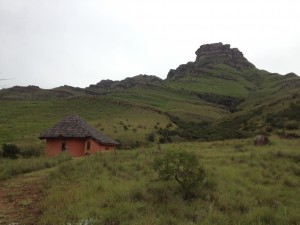 This is a small meditation hut where I often sat (and behind which I watched a troop of several dozen baboons playing and fighting and strolling from one side of the mountain to the other!)
This is a small meditation hut where I often sat (and behind which I watched a troop of several dozen baboons playing and fighting and strolling from one side of the mountain to the other!)
The Next Journey
 I leave tomorrow afternoon for a month-long retreat at Dharmagiri Hermitage in South Africa. I return on Wed, Feb 4, but it may take a while before I’m un-jetlagged and ready to post. So check back on Monday, Feb 9. I should have something posted by then.
I leave tomorrow afternoon for a month-long retreat at Dharmagiri Hermitage in South Africa. I return on Wed, Feb 4, but it may take a while before I’m un-jetlagged and ready to post. So check back on Monday, Feb 9. I should have something posted by then.
In the mean time, I leave you with this quote from Listening to the Heart: A Contemplative Journey to Engaged Buddhism, by Kittisaro and Thanissara, who will be teaching the retreat.
Meditation is the cultivation of a steady mind….When the mind is gathered, collected, and unified, it naturally leads to wisdom, as it sees things realistically, the way they actually are….
Meditation matures us. It enables us to be more realistic and to work with the actualities of life, without being poisoned by the negatively that arises in the face of difficulty….
Ajahn Chah taught, “Do everything with a mind that lets go. Do not expect any praise or reward. If you let go a little, you experience a little peace. If you let go a lot, you experience a lot of peace. If you let go completely, you will know complete peace and freedom. Your struggle with the world will have come to an end.”
****
(photo by Hannah Huffman, from Polaroid Notes, published by Chronicle Books)
Such Teachings As These
 In celebration of the end of the Old Year and the beginning of the New, I offer yet another poem by Mary Oliver — this one a perennial favorite.
In celebration of the end of the Old Year and the beginning of the New, I offer yet another poem by Mary Oliver — this one a perennial favorite.
Mindful
Every day I see or hear something that more or less
kills me with delight, that leaves me like a needle
in the haystack of light. It was what I was born for — to look, to listen,
to lose myself inside this soft world — to instruct myself over and over
in joy, and acclamation. Nor am I talking about the exceptional,
the fearful, the dreadful, the very extravagant — but of the ordinary, the common, the very drab,
the daily presentations. Oh, good scholar, I say to myself, how can you help
but grow wise with such teachings as these — the untrimmable light
of the world, the ocean’s shine, the prayers that are made out of grass?
Birthday Gifts
I am grateful for this precious human birth.
For a mind that’s open to the Buddha’s teachings and a heart that’s inclined to practice.
For my parents, teachers, benefactors, and all the many causes and conditions that have brought this moment into existence.
For the mystery of incarnation.
And for this very breath.
(photo by Mathias Meyer, from Polaroid Notes, published by Chronicle Books)
What If?
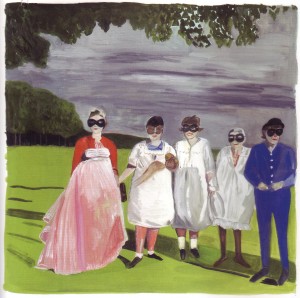 Last night I listened to an excellent talk by Gloria Taraniya, given at the Forest Refuge this past week, in which she offers reflections on not getting caught up in how we SHOULD be, but instead, turning to how we actually ARE.
Last night I listened to an excellent talk by Gloria Taraniya, given at the Forest Refuge this past week, in which she offers reflections on not getting caught up in how we SHOULD be, but instead, turning to how we actually ARE.
She said that as she was struggling with this process, these four questions spontaneous arose in her mind:
1. What if there isn’t any right way to be?
2. What if the way you are is just fine?
3. What if all the self-improvement just compounds the suffering?
4. What if the only problem here is that you think there’s a problem here?
Yeah!
***
(illustration from “My Favorite Things,” by Maira Kalman; click on image to enlarge)
Look Again
 I’m still practicing the “Now I See” exercise I wrote about previously (here and here and here) in which I go to the St. Louis Art Museum, choose a piece of art that “catches my eye,” then look at it awhile and write a page about it in my journal beginning with the phrase: “Now I see…,” then go back a week or more later, look at it some more and write about it again, and then go back and look-and-write until I’ve done it 13 times.
I’m still practicing the “Now I See” exercise I wrote about previously (here and here and here) in which I go to the St. Louis Art Museum, choose a piece of art that “catches my eye,” then look at it awhile and write a page about it in my journal beginning with the phrase: “Now I see…,” then go back a week or more later, look at it some more and write about it again, and then go back and look-and-write until I’ve done it 13 times.
It’s an amazing and enlightening exercise.
There’s nothing magic about doing it 13 times. It just needs to be done a few more times that you think you’ll be able to look at the same frickin’ thing and still be able to write about it!
Also, it’s inspired by this poem by Wallace Stevens, which I don’t exactly understand, but I keep returning to again and again:
Thirteen Ways of Looking at a Blackbird
I
Among twenty snowy mountains,
The only moving thing
Was the eye of the blackbird.
II
I was of three minds,
Like a tree
In which there are three blackbirds.
III
The blackbird whirled in the autumn winds.
It was a small part of the pantomime.
IV
A man and a woman
Are one.
A man and a woman and a blackbird
Are one.
V
I do not know which to prefer,
The beauty of inflections
or the beauty of innuendoes,
The blackbird whistling
Or just after.
VI
Icicles filled the long window
With barbaric glass.
The shadow of the blackbird
Crossed it, to and fro.
The mood traced in the shadow
An indecipherable cause.
VII
O thin men of Haddam,
Why do you imagine golden birds?
Do you not see how the blackbird
Walks around the feet
Of the women about you?
VIII
I know noble accents
And lucid, inescapable rhythms;
But I know, too,
That the blackbird is involved
In what I know.
IX
When the blackbird flew out of sight,
It marked the edge
Of one of many circles.
X
At the sight of blackbirds
Flying in a green light,
Even the bawds of euphony
Would cry out sharply.
XI
He road over Connecticut
In a glass couch.
Once, a fear pierced him,
In that he mistook
The shadow of his equipage
For blackbirds.
XII
The river is moving.
The blackbirds must be flying.
XIII
It was evening all afternoon.
It was snowing
And it was going to snow.
The blackbird sat
In the cedar-limbs.
Waking, Dreaming, Being…Reading
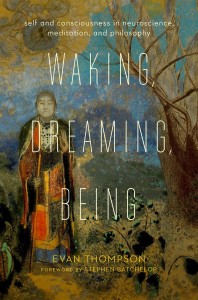 This is an unabashed plug for a remarkable new book, Waking, Dreaming, Being: Self and Consciousness in Neuroscience, Meditation and Philosophy, by Evan Thompson. I stumbled on a review of it in the New York Times late Saturday night and thought WOW!, so I immediately downloaded it onto my iPad and started reading. (Click here for the review.)
This is an unabashed plug for a remarkable new book, Waking, Dreaming, Being: Self and Consciousness in Neuroscience, Meditation and Philosophy, by Evan Thompson. I stumbled on a review of it in the New York Times late Saturday night and thought WOW!, so I immediately downloaded it onto my iPad and started reading. (Click here for the review.)
The book begins with a Forward by Stephen Batchelor, which is terrific, then a Prologue (The Dalai Lama’s Conjecture), and then an Introduction (which gives an overview of the book and a summary of each of the chapters)…and then it gets down to the fundamental questions of consciousness:
Seeing: What Is Consciousness?
Waking: How Do We Perceive?
Being: What Is Pure Awareness?
Dreaming: Who Am I?
Witnessing: Is This a Dream?
Imagining: Are We Real?
Floating: Where Am I?
Sleeping: Are We Conscious in Deep Sleep?
Dying: What Happens When We Die?
Knowing: Is the Self an Illusion?
I’ve just finished “Waking” (chapter 2) and can’t wait to get started on “Being.” If you’re at all interested in the nature of consciousness, especially as it’s addressed by the intersection of Western Neuroscience and Eastern Philosophy/Religion…this is the book for you!
Enjoy.
To Know is To Be Grateful
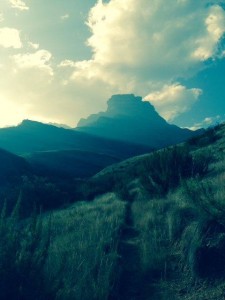 I just received the year-end newsletter from Dharmagiri (which is the Hermitage in South Africa that I’ll be going to in January). It included this photo of the Sacred Mountain (which is the translation of Dharmagiri) along with this message from Kitisarro and Thanissara, who will be leading the retreat:
I just received the year-end newsletter from Dharmagiri (which is the Hermitage in South Africa that I’ll be going to in January). It included this photo of the Sacred Mountain (which is the translation of Dharmagiri) along with this message from Kitisarro and Thanissara, who will be leading the retreat:
“It’s interesting that the the word for gratitude in Pali, katannuta, actually translates as knowing what has been done. Gratitude is less a perfunctory “thanks very much” but more a capacity to appreciate the learning from the whole spectrum of life experiences; even difficulties are something we can be grateful for — usually in retrospect!
“How is that? At some point, once we move out of our reactivity and quiet ourselves into a deeper wisdom, we attune to a knowing that accepts the perfection of our life — just as it is. From there, we are able to feel the blessing of it all.”



